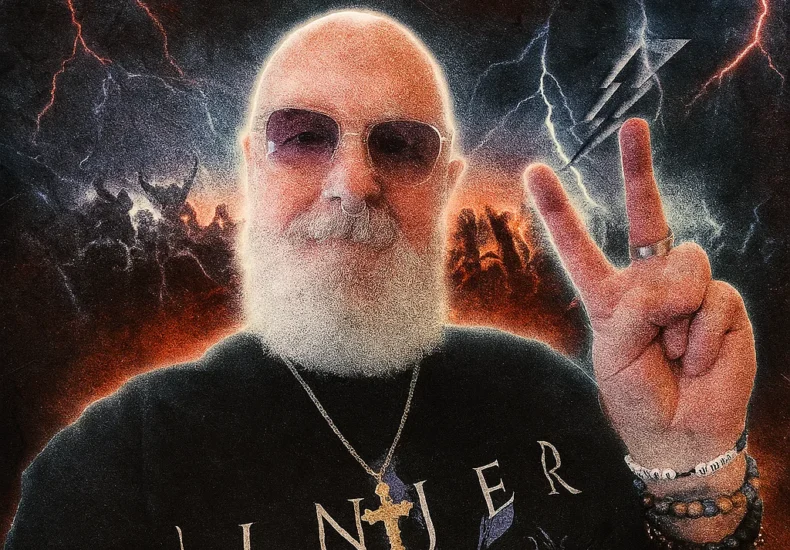
Painkiller and the Priest: Halford’s Immortal Chapter in Heavy Metal”, Full Details⬇️⬇️
From Leather to Legend: Rob Halford’s Iconic Impact on Metal History
Clad in leather and powered by a voice like thunder, Rob Halford shattered musical norms, redefined heavy metal’s edge, and created a timeless legacy that still fuels the fire of generations of metal fans. When Judas Priest stormed the stage in the 1970s, no one quite knew what to make of their sound—or their look. But at the heart of it all was Halford, commanding attention with operatic power and unmatched presence. He wasn’t just fronting a band—he was redefining an entire movement.
Halford’s style was raw, commanding, and theatrical, a blend that transformed Judas Priest into more than a band—they became a blueprint. His leather-and-studs look would eventually become the uniform of an entire genre, copied endlessly by fans and fellow artists alike. Long before image was marketed as a selling point, Rob Halford turned self-expression into heavy metal armor. It wasn’t a costume; it was rebellion, honesty, and defiance stitched into every seam.
But it was the music that truly immortalized him. Albums like British Steel and Screaming for Vengeance carved deep into the genre’s foundation, but it was 1990’s Painkiller that detonated the perception of what Judas Priest—and Halford—could be. That record was a thunderclap, fast and ferocious, with Halford delivering vocals that felt like lightning bolts. He didn’t just sing—he attacked every note with precision and fury, proving that even after decades, he was evolving.
At a time when newer metal genres were rising and the old guard risked fading, Halford doubled down on intensity. Painkiller wasn’t just a comeback—it was a battle cry. The title track remains one of the most iconic performances in metal history, not just for the blistering instrumentation, but for Halford’s vocal acrobatics that scaled octaves like cliffs. Fans were stunned. Critics were silenced. The album reminded the world that Priest was never past their prime—they were only sharpening their edge.
Beyond the studio and stage, Rob Halford’s personal journey further cemented his legendary status. Coming out as gay in 1998 was not only brave—it was historic. In a genre often dominated by hypermasculinity and sometimes homophobic undertones, Halford’s truth resonated with authenticity. He didn’t just challenge stereotypes—he tore them down with grace and strength, becoming a symbol of courage far beyond music.
The combination of musical innovation, fearless self-expression, and relentless integrity helped turn Rob Halford into more than a performer—he became a cultural icon. From his vocal influence on countless metal singers to the generations of artists who cite Painkiller as a game-changer, Halford’s imprint is permanent. He didn’t just follow the genre’s rules—he rewrote them.
Even in the quieter moments of Judas Priest’s career, Halford’s presence never dulled. Whether touring, collaborating with younger acts, or simply speaking on the evolution of metal, he remained relevant and respected. He aged not as a relic, but as a guardian of the genre, a living link between the chaotic origins of heavy metal and its ever-changing present.
In fan communities across the globe, the name Rob Halford inspires reverence. He represents not just the sound, but the soul of metal. His story is proof that authenticity, power, and purpose can echo louder than any amplifier. He didn’t seek trends—he became one. And in doing so, he gave countless fans permission to embrace who they are with volume and pride.
On June 30, 2025, the world stands not just in admiration, but in gratitude. As tributes pour in and retrospectives unfold, it’s clear that Rob Halford’s journey was never just about stardom—it was about transformation. He gave metal not just its roar, but its heart. And in that, his legacy becomes immortal.
To look back at Painkiller now is to witness the fire of a man at full strength, fighting not just for artistic brilliance, but for the very soul of a genre. It was more than an album—it was a declaration. A bold exclamation that metal would never be tamed, not while Halford was at the helm.
For new fans discovering his work or veterans reliving the glory, Halford’s story remains a source of power. His high-pitched screams, unapologetic truths, and towering performances remind us that legends aren’t born—they’re forged. Through sound, struggle, and sheer will, Rob Halford didn’t just change heavy metal. He became it.
And now, as echoes of “The Painkiller” still shake arenas, and the leather-clad silhouette remains burned into rock history, one truth remains—Rob Halford was never merely the voice of metal.
He was its revolution.
You may also like
Archives
Calendar
| M | T | W | T | F | S | S |
|---|---|---|---|---|---|---|
| 1 | 2 | 3 | 4 | 5 | ||
| 6 | 7 | 8 | 9 | 10 | 11 | 12 |
| 13 | 14 | 15 | 16 | 17 | 18 | 19 |
| 20 | 21 | 22 | 23 | 24 | 25 | 26 |
| 27 | 28 | 29 | 30 | 31 | ||
Categories
- 49ers
- Acting
- Afl
- Album
- American football
- Arsenal
- Band
- Baseball
- Basketball
- Biography
- Boston Celtics
- Concert
- Cycling
- Dallas cowboys
- Dallas mavericks
- Discovery
- Ducati MotoGP
- Entertainment
- F1
- Fashion
- Football
- Green bay packers
- Handball
- Hockey
- Liverpool
- MLB
- More Sport
- Motocross
- MotoGp
- NBA
- Netflix Documentary
- NFL
- NRL
- Olympics
- Penrith panthers
- Race
- Real Madrid
- Real Madrid
- Tennis
- Texas rangers
- Tottenham
- Tour
- Uncategorized
- WNBA
- Wwe
Leave a Reply